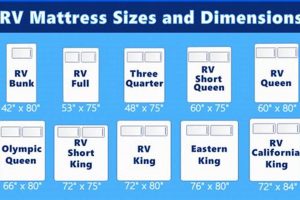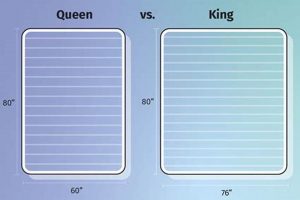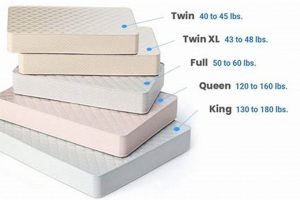The dimensions of an Eastern King mattress, also referred to as a standard King, are typically 76 inches in width and 80 inches in length. These measurements define the rectangular sleeping surface area. For instance, a bed frame designed to accommodate this mattress type should adhere to these specific dimensions to ensure a proper fit.
Accurate knowledge of these figures is essential for several reasons. This information aids consumers in selecting appropriately sized bedding, ensuring optimal comfort and aesthetics. Furthermore, the standard size allows manufacturers to produce consistent products, facilitating easier replacements and upgrades. Historically, this standardization has simplified logistics and inventory management across the bedding industry.
The following sections will delve into related aspects, including comparisons with other mattress sizes, considerations for room size when choosing this mattress type, and the availability of specialized bedding to fit its precise form.
Guidance Regarding Eastern King Mattress Dimensions
The following are considerations to ensure proper selection and utilization of bedding and frames compatible with standard King mattresses.
Tip 1: Verify Room Dimensions: Prior to purchasing an Eastern King mattress, measure the intended bedroom space. Adequate clearance around the bed is necessary for comfortable movement and furniture placement. A minimum room size of 12 feet by 12 feet is generally recommended.
Tip 2: Evaluate Bed Frame Compatibility: Confirm that the chosen bed frame is specifically designed to accommodate the standard King measurements of 76 inches by 80 inches. Using an incompatible frame may result in improper support and reduced mattress lifespan.
Tip 3: Consider Bedding Size: Bedding, including sheets, comforters, and duvet covers, must be appropriately sized for Eastern King mattresses. Standard King bedding sets are designed to accommodate these dimensions, ensuring proper coverage and fit.
Tip 4: Account for Headboard and Footboard: When calculating overall bed size, remember to include the dimensions of the headboard and footboard, as these will add to the overall footprint of the bed within the room.
Tip 5: Measure Doorways and Stairwells: Before delivery, ensure that the mattress can be maneuvered through doorways, stairwells, and hallways. The size and weight of the mattress may require careful planning and potentially professional assistance.
Tip 6: Inspect Mattress Foundation: Verify the integrity of the mattress foundation or box spring. A damaged or sagging foundation can negatively impact the support and comfort of the mattress. Replacement or reinforcement may be necessary.
Tip 7: Check for Accurate Labeling: Always verify the manufacturer’s labeling to confirm that the mattress conforms to the standard King dimensions. Discrepancies can occur, leading to compatibility issues with bedding and frames.
Accurate knowledge of standard King dimensions is paramount for informed purchasing decisions and ensuring long-term satisfaction with the selected sleep system. Proper planning and verification can mitigate potential problems related to fit, comfort, and overall bedroom functionality.
The subsequent sections will elaborate on comparisons with other mattress types and offer insights into maximizing space efficiency with a standard King mattress within various bedroom layouts.
1. Width
The specification of 76 inches for the width of an Eastern King mattress is a critical component of its overall standardized dimensions. This measurement dictates the lateral space occupants have while sleeping, directly influencing comfort and freedom of movement. A narrower mattress may restrict individual movement, while a significantly wider option, such as the California King, caters to different spatial needs. For example, couples who prefer ample personal space often select this mattress configuration. Consequently, inaccurate width dimensions invalidate the mattress’s classification as an Eastern King, leading to incompatibility with specifically designed bed frames and bedding.
A 76-inch width has practical implications for bedroom layout and design. This measurement, coupled with the standard length, dictates the minimum room size required to comfortably accommodate the mattress and allow for sufficient movement. An undersized room could result in constrained mobility and an impractical living space. Furthermore, the width influences the weight distribution across the supporting frame. An improperly sized or constructed frame risks structural failure due to uneven weight bearing across the standardized width.
In summary, the 76-inch width is not merely an arbitrary number; it is an essential and defining characteristic of the Eastern King mattress, affecting comfort, spatial planning, and structural integrity. Deviations from this standard result in functional and practical discrepancies, undermining the intended benefits of the mattress design. Understanding this critical measurement is therefore vital for both consumers and manufacturers in ensuring accurate product selection and utilization.
2. Length
The designation of 80 inches as the length component of the Eastern King mattress dimensions is fundamental. This measurement is not arbitrary; it defines the longitudinal sleeping surface and impacts compatibility, ergonomics, and room planning. Proper comprehension of this dimension is crucial for effective purchasing and utilization of related products.
- Accommodation of Height
The 80-inch length is designed to comfortably accommodate individuals of average height. Taller individuals may find this length insufficient, leading to discomfort and compromised sleep quality. For example, individuals exceeding six feet in height might consider California King mattresses, which offer additional length.
- Bed Frame Compatibility
Adherence to the 80-inch standard is essential for bed frame compatibility. Frames designed for Eastern King mattresses are engineered to precisely fit this length. Deviations from this standard can result in inadequate support, shifting, and potential damage to both the mattress and the frame.
- Bedding Dimensions
The availability of appropriately sized bedding is directly linked to the standardized length. Standard King bedding sets are manufactured to accommodate the 80-inch length. Purchasing bedding not designed for this dimension leads to inadequate coverage and an aesthetically unappealing appearance.
- Room Space Considerations
The 80-inch length contributes significantly to the overall space requirements for the mattress. When planning a bedroom layout, this dimension must be considered alongside the width to ensure sufficient room for movement
and other furniture. Neglecting this aspect can result in a cramped and impractical living space.
In summary, the 80-inch length component is integral to the definition and functionality of an Eastern King mattress. This measurement impacts not only the comfort and ergonomics of the sleeping surface but also the compatibility with supporting structures and associated bedding. Furthermore, it dictates the minimum spatial requirements necessary for effective integration into a bedroom environment. Understanding this length is, therefore, essential for informed purchasing decisions and optimal utilization of the mattress.
3. Area
The calculated area of 6080 square inches serves as a comprehensive metric directly derived from the standard dimensions of an Eastern King mattress. This figure encapsulates the total sleeping surface available, influencing comfort, space utilization, and overall suitability for various users. Understanding the area provides a quantifiable basis for comparison with other mattress sizes and for evaluating room space requirements.
- Comparative Analysis
The area facilitates direct comparison with other mattress sizes. For instance, a Queen mattress possesses a smaller area, while a California King presents a larger one. This differential impacts the available sleeping space per individual, influencing the selection process based on personal preferences and requirements. For example, couples seeking more personal space often prefer the increased area of an Eastern King over a Queen.
- Spatial Planning
The total area contributes to spatial planning within the bedroom. Designers and consumers use this figure to assess the mattress’s footprint relative to the room’s dimensions, ensuring sufficient clearance for movement and the placement of other furniture. An inaccurate assessment could lead to a cramped and impractical environment. Therefore, this measurement plays a key role in interior design and space optimization.
- Material Estimation
Manufacturers utilize the area to estimate material requirements during production. The amount of fabric, foam, and other components is directly proportional to the mattress’s surface area. Precise area calculations are essential for cost optimization and waste reduction in the manufacturing process. Inaccurate estimations lead to material shortages or surplus, affecting profitability and sustainability.
- Weight Distribution
The area indirectly influences weight distribution. The weight of individuals sleeping on the mattress is distributed across this surface. A larger area generally results in lower pressure per square inch, potentially enhancing comfort and reducing stress on specific pressure points. However, the internal structure and materials significantly mediate the effects of the area on weight distribution and overall support.
In summary, the area of 6080 square inches, derived from the length and width of the Eastern King mattress, is a fundamental parameter that influences various factors, including comparative analysis, spatial planning, material estimation, and weight distribution. The understanding of this area contributes to informed decision-making for consumers, designers, and manufacturers alike, ensuring optimal utilization and satisfaction with the selected mattress configuration.
4. Frame Compatibility
Frame compatibility is inextricably linked to Eastern King mattress measurements, serving as a critical determinant of a successful and functional bedding system. The established dimensions of 76 inches by 80 inches for an Eastern King mattress necessitate a corresponding bed frame designed to precisely accommodate these measurements. Failure to adhere to this dimensional congruence leads to a cascade of adverse effects, ranging from compromised support and premature mattress wear to potential safety hazards.
The consequence of using an incompatible frame often manifests as inadequate mattress support. A frame too small causes the mattress to overhang, creating uneven pressure points and accelerating deterioration. Conversely, an oversized frame results in shifting and instability, diminishing sleep quality. For example, attempting to use a Queen-sized frame with an Eastern King mattress inherently compromises its structural integrity. Moreover, frames not engineered for the weight distribution inherent in an Eastern King mattress may experience structural failure over time. The practical significance of frame compatibility extends beyond mere aesthetics; it is fundamental to the longevity, performance, and safety of the entire sleep setup.
In summary, frame compatibility is not merely a peripheral consideration but an essential component directly dictated by Eastern King mattress measurements. This understanding is paramount for ensuring optimal support, extending mattress lifespan, and maintaining safety standards. Addressing the challenges associated with frame compatibility necessitates meticulous attention to dimensional accuracy and structural integrity, thereby fostering a sound and sustainable sleep environment.
5. Bedding Size
The dimensional specifications of an Eastern King mattress directly dictate the required bedding size. A standard Eastern King mattress, with dimensions of 76 inches in width and 80 inches in length, necessitates bedding designed to adequately cover these measurements. Using bedding of an incorrect size leads to functional and aesthetic compromises. Sheets that are too small will not properly fit, resulting in slippage and discomfort. Conversely, bedding excessively large may create an unkempt appearance and impede movement during sleep. For instance, a Queen-sized sheet set is incompatible with an Eastern King mattress due to the significant dimensional disparity.
The implications of appropriate bedding extend beyond superficial aesthetics. Properly sized sheets contribute to the longevity of the mattress by providing a protective barrier against dirt, oil, and wear. Furthermore, fitted sheets that securely grip the mattress reduce friction and prevent bunching, thereby enhancing sleep comfort. The dimensions of comforters and duvet covers also play a pivotal role in thermal regulation. Oversized coverings may trap excessive heat, while undersized options fail to provide adequate insulation. Manufacturers typically label bedding sets with size designations that align with standard mattress dimensions, facilitating informed purchasing decisions. However, variations in manufacturing tolerances can necessitate careful scrutiny of product measurements.
In conclusion, bedding size is a critical component directly determined by the measurements of an Eastern King mattress. Selecting bedding that precisely corresponds to these dimensions is essential for optimizing comfort, preserving mattress integrity, and ensuring aesthetic harmony. Disregarding this relationship results in functional deficiencies and diminishes the overall sleep experience. Precise knowledge of mattress measurements and careful attention to bedding specifications are therefore paramount.
6. Room Dimensions
The relationship between room dimensions and Eastern King mattress measurements is a fundamental consideration in bedroom design and functionality. The standardized measurements of an Eastern King mattress, 76 inches in width and 80 inches in length, directly dictate the minimum spatial requirements for a comfortable and practical bedroom layout. If a room’s dimensions are insufficient, accommodating this mattress size leads to restricted movement, limited furniture placement options, and an overall sense of confinement. For instance, attempting to place an Eastern King mattress in a room measuring 10 feet by 10 feet leaves minimal clearance for walkways and other essential furnishings, thus compromising the room’s usability. Therefore, accurate assessment of room dimensions before purchasing an Eastern King mattress is not merely a matter of convenience but a prerequisite for ensuring spatial harmony and optimizing the bedroom environment.
Real-world examples frequently illustrate the practical significance of this dimensional interplay. Consider the scenario of a master bedroom measuring 12 feet by 14 feet. Placing an Eastern King mattress in this space allows for approximately 3 feet of clearance on either side of the bed and at the foot, enabling comfortable movement and the placement of bedside tables and dressers. Conversely, in a smaller bedroom measuring 10 feet by 12 feet, the same mattress configuration drastically reduces available space, potentially necessitating a different mattress size or a significant reduction in other furniture. This highlights the imperative of carefully measuring room dimensions and considering the placement of existing furniture before making a purchase. Online room planning tools and professional interior design consultations provide resources to aid in visualizing and optimizing spatial arrangements before committing to a specific mattress and furniture layout.
In summary, the spatial compatibility between room dimensions and Eastern King mattress measurements is a critical determinant of bedroom functionality and aesthetic appeal. The mattress’s standardized dimensions directly influence the perceived spaciousness and usability of the room. Accurate assessment of room dimensions, coupled with careful consideration of furniture placement, ensures that the bedroom remains a comfortable and functional living space. Neglecting this fundamental relationship leads to spatial constraints and a compromised bedroom environment.
Frequently Asked Questions
This section addresses common inquiries regarding the dimensions of Eastern King mattresses, providing clarity and resolving potential uncertainties.
Question 1: What are the precise measurements of an Eastern King mattress?
An Eastern King mattress measures 76 inches in width and 80 inches in length. These dimensions define its standard rectangular sleeping surface.
Question 2: Is there a difference between an Eastern King and a Standard King mattress?
The terms “Eastern King” and “Standard King” are synonymous. Both refer to a mattress with the dimensions of 76 inches by 80 inches.
Question 3: How do Eastern King mattress measurements compare to those of a California King?
While both are considered King-sized, the California King is longer and narrower than the Eastern King. A California King typically measures 72 inches in width and 84 inches in length.
Question 4: What room size is recommended to comfortably accommodate an Eastern King mattress?
A room size of at least 12 feet by 12 feet is generally recommended to ensure adequate space for movement and the placement of other bedroom furniture.
Question 5: What happens if a bed frame is not precisely sized to match Eastern King mattress measurements?
Using an improperly sized bed frame can compromise mattress support, reduce its lifespan, and potentially create safety hazards due to shifting and instability.
Question 6: Are standard King-size bedding sets compatible with Eastern King mattresses?
Yes, bedding labeled as “King” or “Standard King” is designed to fit Eastern King mattresses, assuming consistent manufacturing standards.
Accurate understanding of these dimensional specifications is essential for informed purchasing decisions and optimizing bedroom layout.
The subsequent sections will explore advanced considerations, including mattress construction and material composition.
Conclusion
This exploration has detailed the significance of “eastern king mattress measurements,” underscoring their impact on comfort, spatial planning, and compatibility with related products. The specific dimensions of 76 inches by 80 inches are not arbitrary figures but foundational parameters that influence bed frame selection, bedding purchases, and the overall functionality of a bedroom.
A thorough understanding of these measurements is essential for making informed decisions that promote long-term satisfaction and optimize the sleeping environment. As technology advances and preferences evolve, adherence to standardized dimensions will remain a crucial factor in ensuring compatibility and maximizing the value of investments in bedding and bedroom furnishings.


![Best Walmart King Size Blow Up Mattress [Deals!] Organic & Natural Mattress Buyer’s Guide: Non-Toxic Sleep Solutions Best Walmart King Size Blow Up Mattress [Deals!] | Organic & Natural Mattress Buyer’s Guide: Non-Toxic Sleep Solutions](https://mattressworldpa.com/wp-content/uploads/2025/07/th-8177-300x200.jpg)


![Best Soft King Mattress [Guide] For Restful Sleep Organic & Natural Mattress Buyer’s Guide: Non-Toxic Sleep Solutions Best Soft King Mattress [Guide] For Restful Sleep | Organic & Natural Mattress Buyer’s Guide: Non-Toxic Sleep Solutions](https://mattressworldpa.com/wp-content/uploads/2025/07/th-8174-300x200.jpg)

